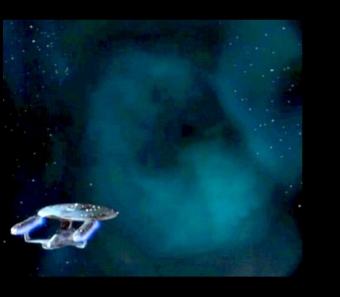
A tear in the fabric of spacetime, a temporal rift is a
highly dangerous temporal anomaly in the Star Trek universe. There have
been numerous encounters with such rifts, in many cases, the vessel
making the encounter has been transported through space and time. The
USS Bozeman entered a temporal disturbance in the Typhon Expanse in
2278, and traveled to the year 2368, where it collided with the USS
Enterprise-D and started a temporal causality loop. (TNG: "Cause and
Effect")
The Enterprise-D encountered a temporal rift-like
phenomenon in the region of Archer IV in 2366. The rift was identified
as a Kerr loop formed from superstring material. The rift had, in fact,
transported the USS Enterprise-C and its crew from 2344 and the
Narendra system. The disappearance of the vessel from its proper place
in time caused the formation of an alternate timeline, which was
resolved by taking the Enterprise-C back through the rift, leaving no
direct evidence of the temporal upheaval. (TNG: "Yesterday's
Enterprise")
The creation of artificial temporal rifts allowed
certain 29th century Starfleet vessels to travel through time. The Aeon
used a temporal rift to travel back to 2373 in order to destroy USS
Voyager. When the rift destabilized, both Voyager and Aeon were pulled
in by the gravimetric forces, ending up in the 20th century. (VOY:
"Future's End", "Future's End, Part II"). In 2404 of an alternate
timeline, Admiral Kathryn Janeway opened and traveled through a
temporal rift to help Voyager return home 16 years earlier than it did.
Her plan worked, allowing Voyager to return from the Delta Quadrant in
2378 rather than 2394. (VOY: "Endgame").
It is not known what the Kerr loops mentioned above are,
but real physics does feature the Kerr wormhole and the Kerr vacuum.
There are four known, exact, black hole solutions to
Einstein's equations describing gravity in General Relativity. Two of
these (Kerr black hole or Kerr-Newman black hole) are rotating.
In general relativity, the Kerr vacuum (more commonly
referred to as the Kerr metric) describes the geometry of spacetime
around a rotating massive body. According to this metric, such rotating
bodies should exhibit frame dragging (rotating bodies dragging
spacetime around themselves). Roughly speaking, this effect predicts
that objects coming close to a rotating mass will be entrained to
participate in its rotation, not because of any applied force or torque
that can be felt, but rather because the curvature of spacetime
associated with rotating bodies. At close enough distances, all objects
— even light itself — must rotate with the body; the region where this
holds is called the ergosphere.
The Kerr metric is often used to describe rotating black
holes, which exhibit even more exotic phenomena. Such black holes have
two surfaces where the metric appears to have a singularity; the size
and shape of these surfaces depends on the black hole's mass and
angular momentum.
The superstring material mentioned above may allued to
materials in superstring theory. In real physics, superstring theory is
an attempt to explain all of the particles and fundamental forces of
nature in one theory by modelling them as vibrations of tiny
supersymmetric strings. It is considered one of the most promising
candidate theories of quantum gravity. Superstring theory is a
shorthand for supersymmetric string theory because unlike bosonic
string theory, it is the version of string theory that incorporates
fermions and supersymmetry.
|
